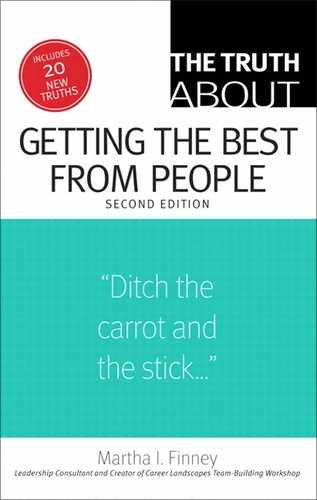Truth 50. Everyone can be creative
Creativity is an essential component to any department today. It’s the key to differentiation that will make you stand out among all your competitors, no matter what service or product you’re providing your customers. This might actually come as bad news to you if you’re not accustomed to thinking of yourself (or your department) as the creative type.
Or it might come as even worse news if you’ve been wishing all along that you were creative and having been watching your competitors eat your lunch. If you’ve tried to train your employees to be more creative, you probably know this already: Creativity may be a discipline, but it’s not a teachable skill. It’s more of a frame of mind that allows people to be more receptive to making fresh connections of notions that result in breakthrough ideas. So you can’t teach creativity, but you can nurture it by providing an environment that inspires and invigorates your employees.
Creativity may be a discipline, but it’s not a teachable skill. It’s more of a frame of mind.
• Take your employees on “artist dates.” In her book The Artist’s Way, Julia Cameron recommends that her readers (primarily writers and visual artists) leave their desks and easels and go out into the world a couple of times a week to expose their souls to fresh colors, textures, and experiences that will eventually find their way into their work. Similarly at Ferrari, director of HR and organization Mario Almondo brings the artist dates to his employees via the Creativity Club. During this special event, Ferrari brings in jazz musicians, painters, writers, orchestra conductors, and actors to show its employees how artists come up with new ideas and solve creative problems.
• Dissolve your silos. Cross-pollinate your potential for ideas by bringing in employees from different departments to work on problems and their solutions. The fresh perspectives that outsiders will lend your group won’t be censored with the prejudice of “we’ve already tried that” or “that can’t be done.” Likewise, lend your people to other departments so they can experience the creative satisfaction of offering their ideas to other people’s problems.
• Give your people what they need. The notion of starving artist is charming only in Puccini operas. Your employees need money, time, rest, play, positive reinforcement, encouragement, and guidance to stay energized, hopeful, and courageous enough to keep coming up with new ideas and approaches to old problems.
Breakthrough ideas typically happen most the day after the subjects reported feeling especially happy.
• Make your people happy. yesterday. Researchers have discovered that breakthrough ideas usually don’t happen at the peak moment of happiness. Instead, breakthrough ideas typically happen most the day after the subjects reported feeling especially happy.
• Find ways to help your employees remember the meaning of their work. Harvard Business School Professor Theresa Amabile says, “People are most creative when they care about their work and they’re stretching their skills.” Never let your employees lose sight of the meaning behind the work they do. No matter what your employees do, if they do it successfully, they’re making life better or easier for someone. So bring some of your employees’ customers into your organization so that they can tell the story of how your product or service made a difference to them. When you make sure they don’t lose sight of that fact, you nurture their potential for creativity.
• Open your department to volunteers. Mark Twain once wrote that the definition of work is something you used to do for love but now you do for money. From the phenomena of YouTube and Wikipedia, we have learned that the public’s passion extends into even the geekiest of pursuits, such as building an encyclopedia. If an encyclopedia project can attract volunteers, surely there’s something about your organization that can appeal to discretionary passion. If there is, open your doors to this group and let their energies infect your employees.
People are most creative when they care about their work.
As the engaging manager, you’re in a bind. You’re responsible for generating great performance and products that result from creativity. But you can’t force creativity. All you can do is provide an environment where it can thrive. How you go about that is a creative challenge with your name on it.
